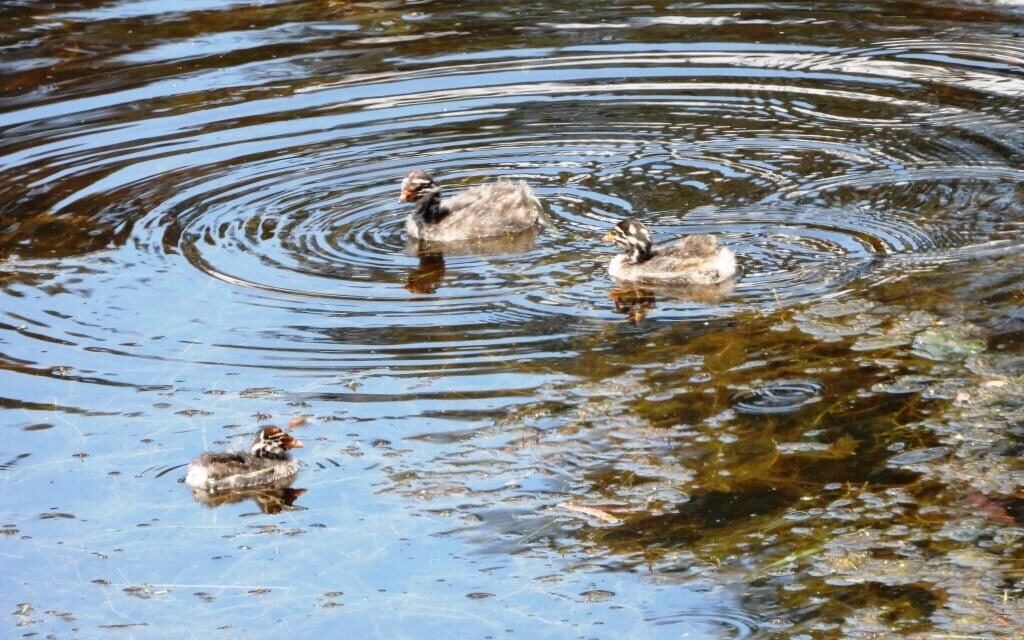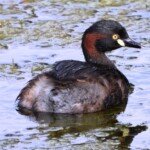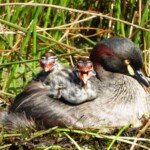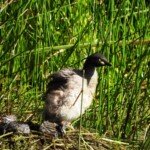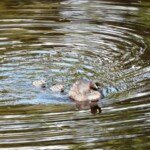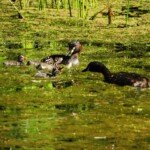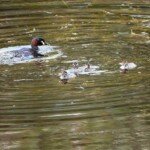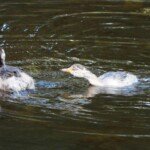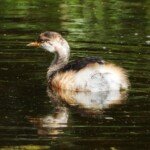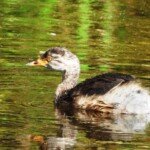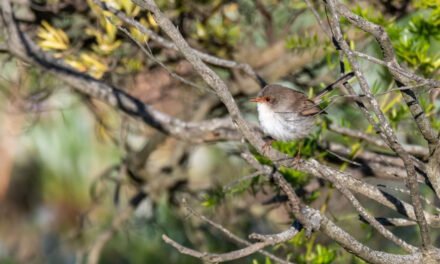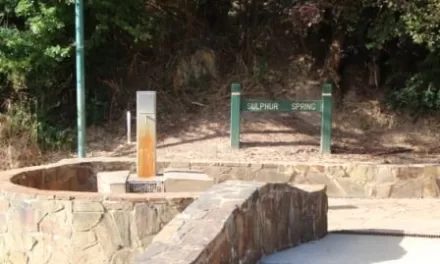Margaret Hodge
This is a sequel to Gorgeous Grebe Chicks Emerge in Garden Dam from The Wombat Post in early December.
Recent wet, wild weather brought mixed blessings.
Our dam gradually shrinks each summer, but this season’s high rainfall topped it up periodically so the aquatic plants thrived as a plentiful food source. Sometimes more than 40 birds shared its abundance, including wood ducks, black ducks, herons, a pair of teals and the grebe family.
As the four young grebes grew, there was much swimming, chatter, swapping between parents’ backs, longer independent dives and feeding themselves from their own catch. Each day the parents increased their own dive times and distances away from the young, until sometimes both parents were underwater for short periods leaving the chicks swimming above. The chicks followed their parents lead in grooming their fluffy down, choosing where to feed and orientating themselves to the sun’s warmth. The family slept on the floating nest that gradually became grounded as the water level dropped, chicks snuggled under parental wings for warmth and shelter from the weather.
When the chicks were almost 3-weeks old, we woke one morning to find just three grebe chicks alone in the dam. Both parents and one chick were gone.
Grebe chicks usually remain with their parents until 8 to 10 weeks after hatching. Adult grebes may then start another clutch and chase the older chicks away, or fly to another suitable wetland to start another clutch, and sometimes they return for a visit to check on their older family. Grebes mostly fly at night so you don’t often see them flying. Their feet are huge and built for paddling; you rarely see them walk far.
We don’t know what prompted the adults to leave. I searched around the dam and found no evidence of bird deaths, no feathers or disturbed plants. It is unlikely the missing chick was carried on a flying parent’s back, like a princess on a dragon, to another home. Maybe the little one was taken by a predator and the parents fled? We’ll never know.
The three remaining grebes were so young.
They were quiet on that first day alone. They stayed together, fed themselves and followed the sunshine for warmth. One chick was smaller than the others and tended to feed closer to the shore. They did not go near the nest. Instead, overnight they clustered around a rush growing through water beneath the low bow of an ageing wattle, near a family of black ducks camped on shore. This impressive survival behaviour continued for days. Other water birds stayed away from the growing chicks while sharing the dam with them.
Christmas Eve night was wildly stormy and very cold, with strong wind and heavy rain. At dusk I watched the grebe chicks swim to shelter, on water, under curved iris leaves that would provide some protection from the driving rain and south-easterly wind. The smallest went in to shelter first while the largest continued feeding in the rain.
At dawn on Christmas Day just two grebe chicks were alive. The littlest body floated cold under the irises.
The two surviving chicks were feeding, they looked strong and capable. The weather warmed up and they had the skills they needed to live on the freshly topped up dam.
Other water birds and the grebe chicks became more comfortable being near each other. A black duck stood on the small pontoon that is often occupied by ducks, while the grebes swam nearby, using the pontoon side as shelter from the wind. Then the grebe chicks scrambled up the pontoon ramp to sit in the sun and warm up beside the black duck. After that the grebes slept near the pontoon using it as a wind break, occasionally sunning themselves on it during the day.
Two teals moved onto the dam and formed a friendly relationship with the grebe chicks over the next few weeks. They often fed near each other or swam together. The teals responded early to possible threats and their response seemed to alert the young grebes who followed their lead in quickly moving quietly away from possible danger. This on water avoidance suited the chicks that were too young to fly away like ducks and heron.
Around 8-weeks of age, the two grebes looked almost fully grown, although their size was hard to judge without adults for comparison. Their plumage was much more like adult non-breeding grebes, with dark grey wings, bronze-tinted sides and a fluffy pale grey backside. One grebe was darker and had more bronze than the other.
We loved watching them grow. They got so good at diving for longer times and distances. We watched them stretch their powerful legs out in the water or rest their huge feet on their own backsides. Their wing feathers grew to form beautiful fans when expanded. They flapped their ‘new’ wings while running on water in that characteristic grebe gait. Maybe it was preparation for flying?



We hoped they’d stay forever.
But 9-weeks after they hatched, both grebes were gone. The darker-coloured one set out two nights before the other. There was no evidence of bird death and, as they were around the age of independence, they probably flew off overnight to another wetland. Fledged.
Margaret Hodge is a Daylesford resident and keen observer of nature. Photos from Vanessa Craven, Daylesford resident and multi-talented creative with one focus in photographing birds.

